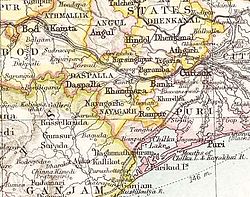Baramba State
| Baramba State ବଡମ୍ବା ରାଜ୍ୟ | |||||||
|---|---|---|---|---|---|---|---|
| Princely State of British India | |||||||
| 1305–1948 | |||||||
|
Flag | |||||||
 Baramba State in the Imperial Gazetteer of India | |||||||
| Area | |||||||
• 1892 | 368 km2 (142 sq mi) | ||||||
| Population | |||||||
• 1892 | 29772 | ||||||
| History | |||||||
| History | |||||||
• Established | 1305 | ||||||
| 1948 | |||||||
| |||||||
| Today part of | Odisha, India | ||||||
Baramba State (Odia: ବଡମ୍ବା ରାଜ୍ୟ) was one of the princely states of India during the period of the British Raj. The state was founded in 1305 and had its capital in Baramba town. Its last ruler signed the accession to the Indian Union on 1 January 1948. Baramba state was made part of Cuttack district of Odisha in 1948.
History[edit | edit source]
According to family and court records, Baramba State was founded in 1305 when the land comprising two villages, Sonkha and Mohuri, were granted by the then Eastern Ganga emperor Narasimha Deva II, to a wrestler Hatakeshwar Raut of the Khandayat community in recognition for his valour.[1][2][3] The original two villages have now merged into the present town of Sankhameri.[4] The last ruler of Baramba Princely State signed the accession to the Indian Union on 1 January 1948.
Rulers[edit | edit source]
Rulers of Baramba bore the title Raut and the emblem of the Baramba royal family was a leopard.[5]
- Hatakeshwar Raut (1305–1327)
- Malakeshwar Raut (1327–1345)
- Durgeshwar Raut (1345–1375)
- Jambeswar Raut (1375–1416)
- Bholeswar Raut (1416–1459)
- Kanhu Raut (1459–1514)
- Madhab Raut (1514–1537)
- Nabin Raut (1537–1560)
- Brajadhara Raut (1560–1584)
- Chandrasekhar Mangaraj (1584–1617)
- Narayan Chandra Mangaraj (1617–1635)
- Krushna Chandra Mangaraj (1635–1650)
- Gopinath Chandra Mangaraj (1650–1679)
- Balabhadra Mangaraj (1679–1711)
- Fakir Mangaraj (1711–1743)
- Banadhar Mangaraj (1743–1748)
- Padmanava Birbar Mangaraj (1748–1793)
- Pindika Birbar Mangaraj Mahapatra (1793–1842)
- Gopinath Birbar Mangaraj Mahapatra (1842–1869)
- Dasarathi Birbar Mangaraj Mahapatra (1869–15 July1881)
- Bishambhar Birbar Mangaraj Mahapatra (15 July 1881–20 August 1922)
- Narayan Chandra Birbar Mangaraj Mahapatra (20 August 1922–1 January 1948)
Titular[edit | edit source]
- Narayan Chandra Birbar Mangaraj Mahapatra (1 January 1948–15 October 1954)
- Krushna Chandra Deb Birbar Mangaraj Mahapatra (15 October 1954–1978)
- Tribikram Chandra Deb Birbar Mangaraj Mahapatra (1979–)
See also[edit | edit source]
References[edit | edit source]
- ↑ ODISHA DISTRICT GAZETTEERS CUTTACK (PDF), GAD, Govt of Odisha, 1993, p. 46-70
- ↑ Cobden Ramsay (1910), Bengal Gazetteers Feudatory States Of Orissa, DLI, p. 129
- ↑ Imperial Gazetteer of India, v. 6, p. 433.
- ↑ "Baramba Princely State". Archived from the original on 5 January 2019. Retrieved 29 June 2014.
- ↑ Princely States of India A-J
Coordinates: 20°25′15″N 85°22′41″E / 20.42083°N 85.37806°E
- Former country articles requiring maintenance
- Articles containing Odia-language text
- Pages using Lang-xx templates
- Princely states of India
- History of Odisha
- Cuttack district
- 14th-century establishments in India
- 1305 establishments in Asia
- 1948 disestablishments in India
- Indian history stubs
- Odisha geography stubs
